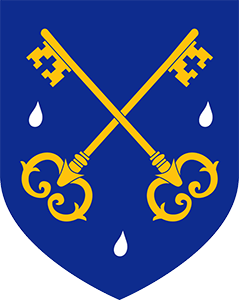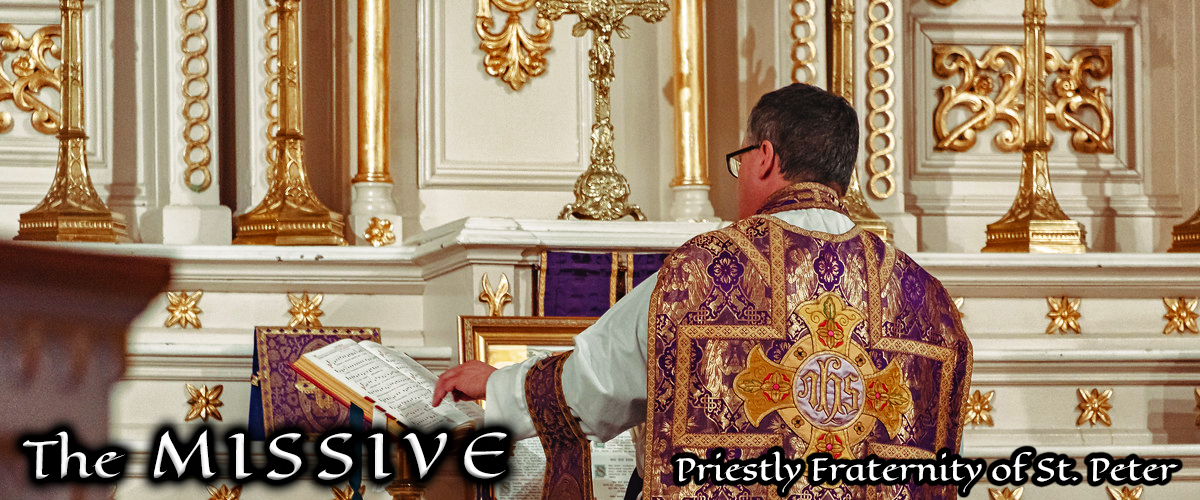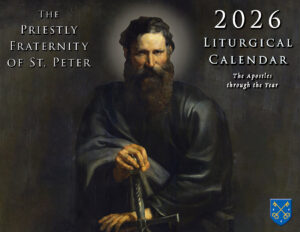The Hebrew Calendar and the Traditional Roman Liturgy
by Fr. Mark Wojdelski, FSSP
I am planning, God willing, to do a series of articles on how the traditional Roman Liturgy aligns with the cycle of Jewish feasts. Having done extensive research, but not knowing where to begin, I informally consulted with some of my brother priests at our last general meeting. One of them said, “What’s a lunar calendar?” So I think that is a good place to start. At the end of this series of articles, it is hoped that people will see what a work of art the ancient Roman liturgy is, not only the Mass, but even the Divine Office. We will also see the continuity between the practice of religion before Christ and after His coming in the flesh. It is like a beautiful symphony that changes keys, but maintains the same harmony. Miracles have been described in this way, as God modulating the cosmic music, rather than violently manipulating His creation. We often speak of the New Testament being hidden within the Old. It appears that the liturgy of the old Covenant is also hidden within the new.
Every Catholic is well aware of the fact that the date of Easter moves around the calendar every year. Not every Catholic knows why. When I was a little boy in Catholic school, Fr. Mike Foley, then a young priest of the Archdiocese of Chicago, taught us the answer to this (perhaps in the fifth or sixth grade), by asking us a question, and promising that if any student knew the answer, that he or she would be exempt from religion class until graduation. Of course, none of us knew the correct answer: that Easter Sunday is always the Sunday after the first full moon after the beginning of spring (formally known as the vernal equinox, but we were only kids, so he spared us the additional astronomy lesson). The Church defines the equinox as March 21 for purposes of unity and consistency, even though the actual equinox can move a bit. So to simplify, we can simply say that the Church has decided that Easter is the Sunday after the first full moon after March 21.
The reason for this is that the crucifixion of our Lord occurred during the feast of the Unleavened Bread, which was observed for seven days after Passover. The feasts of the Jewish religion are all defined by lunar occurrences, specifically counting days after the new moon (when the first sliver of the crescent moon is just visible after the sun sets). The full moon will occur about 14 days after that new moon sighting, and it did need to be seen by human eyes, so the lunar calendar in antiquity was called “observational.” The location that eventually became the standard place of observation for the Jews was naturally Jerusalem. Two witnesses had to come forward to the priests, who would then question them on what precisely they saw (where, how high in the sky, how the moon was oriented) and if their answers were satisfactory, the new moon was declared and the trumpet blown, signifying that the month had begun. The beginning of the month was called “Rosh Hodesh” (the “head of the month”) as we analogously say “Rosh Hashanah” for the Jewish new year. Technically, “hodesh” simply means “newness” in Hebrew.
In fact, in the early church, there was a controversy surrounding the date of Easter, with some insisting that Easter be always celebrated on the fourteenth day of the first month (called Nisan), no matter what day of the week it happened to be, and others saying that it should always be celebrated on a Sunday, the first day of the week, as this was the day our Lord rose from the dead. There are mystical and theological reasons for both positions, but ultimately the second opinion prevailed, and we now celebrate Easter as we do. The discrepancy between the Western celebration of Easter and the Orthodox Easter has nothing to do with the moon, but rather has to do with the fact that the Orthodox continue to use the Julian calendar, which has a drift of three solar days every 400 years, an error that was corrected—quite well, incidentally—by the reform of the calendar under Pope Gregory XIII in 1582. For this reason, the date of Easter on the Orthodox calendar will continue to fall later and later as centuries go by.
* * *
The Hebrew lunar calendar has twelve months, each month having either 29 or 30 days. It takes the moon about 27.3 days to revolve around the earth, but the earth meanwhile is moving around the sun at the same time, and so the observed lunar cycle turns out to be about 29.5 days. The months are as follows:
|
Month |
Name |
Season |
Modern Equivalent |
|
1 |
Nisan (or Abib) |
Spring |
March-April |
|
2 |
Iyar (Ziv) |
Spring |
April-May |
|
3 |
Sivan |
Spring |
May-June |
|
4 |
Tammuz |
Summer |
June-July |
|
5 |
Av |
Summer |
July-August |
|
6 |
Elul |
Summer |
August-September |
|
7 |
Tishri (Ethanim) |
Fall |
September-October |
|
8 |
Heshevan (Bul) |
Fall |
October-November |
|
9 |
Kislev |
Fall |
November-December |
|
10 |
Tevet |
Winter |
December-January |
|
11 |
Shevat |
Winter |
January-February |
|
12 |
Adar |
Winter |
February-March |
The names of the months are taken from the Babylonians, whose astronomers perfected the lunar calendar and the cycles of lunations. The names given in parentheses are the older Canaanite names, which appear in the Old Testament occasionally. This gives us a total of 354 days, assuming an even pattern of alternating 29- and 30-day months. However, because the solar year is 365 days, we are presented with a problem, since after a few years the first month of spring would be so early that there would be no grain to harvest yet, and since Passover and the feast of Unleavened Bread were tied to the growing season, something would have to be done. In order to correct the error in the drifting apart of the cycles of the sun and the moon, the priests would declare a “leap month” after Adar, which they simply called Adar II or Va’Adar (literally “And Adar”). This would then realign the cycle of the sun and moon enough so as not to disrupt society. Later, after the Sanhedrin was disbanded in the fourth century, the rabbis adopted what is called the Metonic cycle, known to the Greeks as well as the Babylonians, by which direct observation of the moon was no longer necessary. A 19-year cycle is used, with a regular pattern of leap months and two months whose length can vary from 29 to 30 days from year to year depending on what is needed to keep everything aligned. This system remains in use to this day.
Before turning to the Christian feasts, a brief general overview of the Hebrew feasts will be helpful. There are other observances which we will look at later as they come up, but the major holidays are enumerated in the book of Leviticus, chapter 23 (RSV2 Catholic Edition):
“The Lord said to Moses, Say to the sons of Israel, The appointed feasts of the Lord which you shall proclaim as holy convocations, my appointed feasts, are these. Six days shall work be done; but on the seventh day is a sabbath of solemn rest, a holy convocation; you shall do no work; it is a sabbath to the Lord in all your dwellings.” (Lev 23:1-3)
This observance is so frequent that it is often forgotten, in the same way that we don’t think much of Sunday when it rolls around every week—unless, of course, you are a priest, then your whole life revolves around it. We will see the phrase “holy convocation” (miqra’ qodesh) come up repeatedly. The term is aptly rendered, as it is literally a “calling of holiness.” The original Christian feast was simply the observance of the new weekly day of rest, Sunday, the day of the Resurrection.
“These are the appointed feasts of the Lord, the holy convocations, which you shall proclaim at the time appointed for them. In the first month, on the fourteenth day of the month in the evening, is the Lord’s Passover. And on the fifteenth day of the same month is the feast of unleavened bread to the Lord; seven days you shall eat unleavened bread. On the first day you shall have a holy convocation; you shall do no laborious work. But you shall present an offering by fire to the Lord seven days; on the seventh day is a holy convocation; you shall do no laborious work.” (Lev 24:4-8)
Here Passover and the associated feast of Unleavened Bread are described. These roughly correspond to our Holy Thursday and Good Friday (the 14th and 15th days of the month, if the synoptic gospel narrative has any value) and the week of Easter. But there is one additional action that must be taken around this time:
“And the Lord said to Moses, Say to the sons of Israel, When you come into the land which I give you and reap its harvest, you shall bring the sheaf of the first fruits of your harvest to the priest; and he shall wave the sheaf before the Lord, that you may find acceptance; on the day after the sabbath the priest shall wave it. And on the day when you wave the sheaf, you shall offer a male lamb a year old without blemish as a burnt offering to the Lord. And the cereal offering with it shall be two tenths of an ephah of fine flour mixed with oil, to be offered by fire to the Lord, a pleasing odor; and the drink offering with it shall be of wine, a fourth of a hin. And you shall eat neither bread nor grain parched or fresh until this same day, until you have brought the offering of your God: it is a statute for ever throughout your generations in all your dwellings.” (Lev 23:9-14)
There are two different traditions (Rabbinic and Sadducean/Karaite) on how to determine what “the day after the sabbath” means. The way that ends up determining the Christian calendar is to have this day be the day after the Sabbath that falls within the week of Passover. In our case, that would be Easter Sunday itself, as Holy Saturday was the Sabbath within that feast. This means that Pentecost would always fall on a Sunday in this arrangement, no matter what day Passover falls on. Holy Saturday and Easter Sunday are thus the 16th and 17th days of Nisan respectively. It is interesting that the arrangement followed is that of the Sadducees, who were also in power at the time of Christ. The other interpretation gained traction after they lost their influence, but theirs is considered the more literal reading of the sacred text, and the Karaites have continued that tradition, as the modern Torah-thumping fundamentalists.
“And you shall count from the day after the sabbath, from the day that you brought the sheaf of the wave offering; seven full weeks shall they be, counting fifty days to the day after the seventh sabbath; then you shall present a cereal offering of new grain to the Lord. You shall bring from your dwellings two loaves of bread to be waved, made of two tenths of an ephah; they shall be of fine flour, they shall be baked with leaven, as first fruits to the Lord. And you shall present with the bread seven lambs a year old without blemish, and one young bull, and two rams; they shall be a burnt offering to the Lord, with their cereal offering and their drink offerings, an offering by fire, a pleasing odor to the Lord. And you shall offer one male goat for a sin offering, and two male lambs a year old as a sacrifice of peace offerings. And the priest shall wave them with the bread of the first fruits as a wave offering before the Lord, with the two lambs; they shall be holy to the Lord for the priest. And you shall make proclamation on the same day; you shall hold a holy convocation; you shall do no laborious work: it is a statute for ever in all your dwellings throughout your generations. And when you reap the harvest of your land, you shall not reap your field to its very border, nor shall you gather the gleanings after your harvest; you shall leave them for the poor and for the stranger: I am the Lord your God.” (Lev 23:15-22)
This corresponds to our feast of Pentecost, which comes from a Greek word that simply means “fiftieth.” No further comment is necessary, but it is helpful to keep in mind that it is an additional feast of the harvest in the spring.
“And the Lord said to Moses, Say to the sons of Israel, In the seventh month, on the first day of the month, you shall observe a day of solemn rest, a memorial proclaimed with blast of trumpets, a holy convocation. You shall do no laborious work; and you shall present an offering by fire to the Lord.” (Lev 23:23-25)
This is the civil new year, which begins in the fall. As we look at the calendar we see a certain symmetry between the fall and the spring, between Nisan and Tishri especially. This is easily seen if the table above is referred to. In this case, however, the first day of the month is also a solemn day of rest, while the first day of Nisan is not.
“And the Lord said to Moses, On the tenth day of this seventh month is the day of atonement; it shall be for you a time of holy convocation, and you shall afflict yourselves and present an offering by fire to the Lord. And you shall do no work on this same day; for it is a day of atonement, to make atonement for you before the Lord your God. For whoever is not afflicted on this same day shall be cut off from his people. And whoever does any work on this same day, that person I will destroy from among his people. You shall do no work: it is a statute for ever throughout your generations in all your dwellings. It shall be to you a sabbath of solemn rest, and you shall afflict yourselves; on the ninth day of the month beginning at evening, from evening to evening shall you keep your sabbath.” (Lev 23:26-32)
This introduces another important principle in Hebrew timekeeping: feasts and religious observances always begin at sunset and end at sunset, even though the beginning of the day was still considered sunrise. The Day of Atonement (Yom Kippur) was a single day of reparation for sin. The term “afflict your souls” is a technical term referring to fasting.
“And the Lord said to Moses, Say to the sons of Israel, On the fifteenth day of this seventh month and for seven days is the feast of booths to the Lord. On the first day shall be a holy convocation; you shall do no laborious work. Seven days you shall present offerings by fire to the Lord; on the eighth day you shall hold a holy convocation and present an offering by fire to the Lord; it is a solemn assembly; you shall do no laborious work.
“These are the appointed feasts of the Lord, which you shall proclaim as times of holy convocation, for presenting to the Lord offerings by fire, burnt offerings and cereal offerings, sacrifices and drink offerings, each on its proper day; besides the sabbaths of the Lord, and besides your gifts, and besides all your votive offerings, and besides all your freewill offerings, which you give to the Lord.
“On the fifteenth day of the seventh month, when you have gathered in the produce of the land, you shall keep the feast of the Lord seven days; on the first day shall be a solemn rest, and on the eighth day shall be a solemn rest. And you shall take on the first day the fruit of goodly trees, branches of palm trees, and boughs of leafy trees, and willows of the brook; and you shall rejoice before the Lord your God seven days. You shall keep it as a feast to the Lord seven days in the year; it is a statute for ever throughout your generations; you shall keep it in the seventh month. You shall dwell in booths for seven days; all that are native in Israel shall dwell in booths, that your generations may know that I made the sons of Israel dwell in booths when I brought them out of the land of Egypt: I am the Lord your God. Thus Moses declared to the sons of Israel the appointed feasts of the Lord.” (Lev 23:33-44)
This feast, variously called “Booths,” “Tabernacles,” or the Hebrew name “Succoth,” is in a sense the fall version of the spring feast of Passover and Unleavened Bread, both of which occur on the full moon of the month.
By now, the reader probably needs a break to allow these ideas to settle in before we start to examine the traditional Roman liturgical year in greater detail. I am aware that “everyone knows” that the Ember Days in September relate to these last three observances in the month of Tishri, namely, The New Year, the Day of Atonement, and the feast of Tabernacles. I invite you to take an altar missal (or most any vernacular hand missal), take an ordinary calendar, find Pentecost Sunday, write “7 Sivan” in the space, and then count the weeks between Pentecost Sunday (which we define as 7 Sivan, 7 weeks after 17 Nisan, Easter) and 10 Tishri, the day of atonement. Suppose Sivan has 29 days, and then they alternate: Tammuz would have 30 days, Av 29 days, Elul 30 days. Since it is an even number of months, it could just as easily go 30, 29, 30, 29, but as we will see later, Sivan must have 29 days in this idealized calendar for a very important reason. You will find that 10 Tishri falls on a Tuesday within a certain week after Pentecost. It will in fact be the week of the seventeenth Sunday after Pentecost. After doing this, open your missal and see what comes immediately after that Sunday in in the missal. Then look two Sundays after that (22 Tishri), which would be the eighth day of Succoth, the day of “solemn convocation” (i.e. “calling of holiness”), make note of the gospel reading, and know that God has not abandoned His people. More on the month of Tishri (i.e. the sixteenth through twentieth Sundays after Pentecost) is on the way.
September 22, 2025








